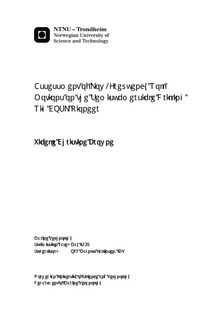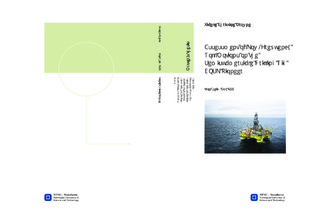| dc.description.abstract | Excessive roll motions were registered on the drilling rig COSL Pioneer on January 25th 2012. Calculations performed by Global Maritime showed less roll motions than registered, but were consistent with the other five degrees of freedom. It was suspected that the excessive motions could have been induced by the low-frequency forces from the thrusters. The main objective of this thesis was to regenerate and identify the cause of these excessive roll motions.A frequency-domain analysis of the bare hull was performed in HydroD, with the potential flow solver Wadam. A panel model and structural data for the frequency-domain analysis were provided by Global Maritime. The hydrodynamic data from Wadam was exported to OrcaFlex, the program used for the time-domain analysis. The rig and its anchor lines were modelled in OrcaFlex while the drilling riser was omitted from the analysis due to its small influence on the motions of the rig. The forces from the thrusters were calculated in a separate program written in the programming language Python. A very simple dynamic positioning system was applied since only scarce information about the thrusters and the dynamic positioning system was made available.The thruster forces calculated in the Python-program were implemented in OrcaFlex as two forces and a moment acting in the earth-fixed horizontal plane. The thruster forces were calculated using an algorithm for a Proportional Integral Derivative controller, also known as a PID controller. A PID controller has three controller gain coefficients that were estimated on the basis of a uncoupled and linear simplification of the real system. Simulations were also run for the same PID controller with gains that were 50\% higher and 50\% lower than the original estimate. A simulation without any inclusion of thruster forces was run and used as reference.No thruster-induced motions were registered in the time-domain simulations with PID controllers. The transverse thruster force was therefore replaced with a harmonic force with a period in roll equal to that of the simulation with the PID controller and in a direction that was initially in phase with the roll motion. However, the harmonic thruster load increased the roll motions, but they were still significantly smaller than on January 25th 2012.A real dynamic positioning system calculates the thruster forces on the basis of the low-frequent horizontal motions of the vessel. This was initially attempted, but then abandoned as the second-order Butterworth filter that OrcaFlex applies in order to filter low-frequency from wave-frequency motions introduced a phase lag. The phase lag was of approximately 25\degree and the caused the amplitudes of the motion to diverge.The standard deviations for surge, sway, heave, roll and pitch from all the simulations in OrcaFlex were compared to the standard deviations of the registered motions between 18:00 and 18:55 on January 25th 2012. The registered motions had standard deviations that were approximately twice as large in roll and had half the values in heave. The standard deviations in surge, sway and yaw were of the same magnitude in the time-domain simulations and on January 25th 2012.The deviations between the registered motions and the simulations are assumed to be predominantly due to the simplifications regarding the thrusters. The most significant simplifications were the forces' point of application, direction and that the wave frequency motion was included in the calculation of the forces. | nb_NO |

